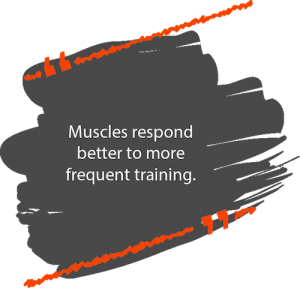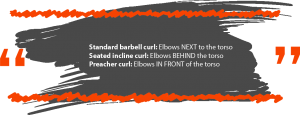
How Can I Get Great Biceps?
Jan 13, 2018 mindpumpA bulging pair of biceps is one of the most immediately noticeable signs of a strong, healthy individual. Are your biceps lagging?
Incorporate the following into your training:
Volume & Frequency
Granted you have good recovery and follow a solid training program (I highly recommend MAPS AESTHETIC), VOLUME is the biggest key to increasing muscle size. (Volume = load x reps x sets). If you curled 100 lbs 10 reps for 3 sets, your total volume for curls was: 100 x 10 x 3 = 3000.

To fix lagging muscle groups, start by upping the volume a bit. One of the easiest ways to do this ties in with another EXTREMELY IMPORTANT muscle building principal: FREQUENCY. Muscles respond better to more frequent training. (For more on why frequency is so important, check out my blog: Why Can’t I Gain More Muscle)

If you’re following good programming, you’re already training your biceps AT LEAST twice a week. Simply add 2-3 sets of 8-12 of some curl variation to a training day where you DON’T normally train arms. This won’t seem like a lot, but will up your weekly volume and frequency drastically.
It’s easy to overdo things when applying more volume. More isn’t always more. Start by just adding in bicep work on one training day you wouldn’t normally do bicep specific movements. See how your body responds. Over time, you can gradually apply this concept to more training days until you start to see the changes you want.
Work the Angles
It’s important to vary the angles you use when training biceps (think: changing where your elbows are in relation to your torso). Consider three different bicep curl variations:

Due to the different angles and elbow positioning being used, each exercise has a much different point during the rep where muscle activity is maximized. Changing the angles you work the biceps with is presenting the body with new stimulus; crucial to keep muscles adapting and growing. For more on this:
Full Range of Motion
If you’re not training your bicep exercises through their full range of motion, you’re shorting yourself muscle growth on EVERY REP. Full range of motion leads to more muscle damage, which in turn leads to more muscle growth.
There is a time and a place for shorter range of motion reps (i.e. chasing the pump). Just make sure the majority of your training is focused on taking the muscle through full range of motion.
Focus on the Negatives
The eccentric (lowering) portion of the rep isn’t something we think about a lot. However, a large part of the muscle damage we acquire during a training session actually occurs during the eccentric portion of your reps.
If you’re simply dropping the weight from the top of your curls, you’re not maximizing the exercise. For more muscle growth, focus on slow, controlled 3-4 second negatives when curling.
Don’t Major in the Minors
Bicep specific training is important for good arms, but it shouldn’t make up the majority of your training. Movements like deadlifts, chin-ups, etc. will create the most change in your body, and will provide a HUGE bicep building stimulus to boot. Focus on your foundational, multi-joint movements first. Add in your bicep specific work AFTER, using the above concepts.







